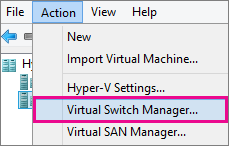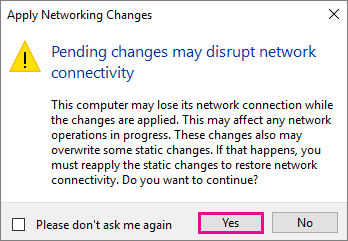How to detect, enable and disable SMBv1, SMBv2, and SMBv3 in Windows and Windows Server
Summary
This article describes how to enable and disable Server Message Block (SMB) version 1 (SMBv1), SMB version 2 (SMBv2), and SMB version 3 (SMBv3) on the SMB client and server components.
Warning
We recommend that you do not disable SMBv2 or SMBv3. Disable SMBv2 or SMBv3 only as a temporary troubleshooting measure. Do not leave SMBv2 or SMBv3 disabled.
In Windows 7 and Windows Server 2008 R2, disabling SMBv2 deactivates the following functionality:
- Request compounding - allows for sending multiple SMB 2 requests as a single network request
- Larger reads and writes - better use of faster networks
- Caching of folder and file properties - clients keep local copies of folders and files
- Durable handles - allow for connection to transparently reconnect to the server if there is a temporary disconnection
- Improved message signing - HMAC SHA-256 replaces MD5 as hashing algorithm
- Improved scalability for file sharing - number of users, shares, and open files per server greatly increased
- Support for symbolic links
- Client oplock leasing model - limits the data transferred between the client and server, improving performance on high-latency networks and increasing SMB server scalability
- Large MTU support - for full use of 10-gigabye (GB) Ethernet
- Improved energy efficiency - clients that have open files to a server can sleep
In Windows 8, Windows 8.1, Windows 10, Windows Server 2012, and Windows Server 2016, disabling SMBv3 deactivates the following functionality (and also the SMBv2 functionality that's described in the previous list):
- Transparent Failover - clients reconnect without interruption to cluster nodes during maintenance or failover
- Scale Out – concurrent access to shared data on all file cluster nodes
- Multichannel - aggregation of network bandwidth and fault tolerance if multiple paths are available between client and server
- SMB Direct – adds RDMA networking support for very high performance, with low latency and low CPU utilization
- Encryption – Provides end-to-end encryption and protects from eavesdropping on untrustworthy networks
- Directory Leasing - Improves application response times in branch offices through caching
- Performance Optimizations - optimizations for small random read/write I/O
More Information
The SMBv2 protocol was introduced in Windows Vista and Windows Server 2008.
The SMBv3 protocol was introduced in Windows 8 and Windows Server 2012.
For more information about the capabilities of SMBv2 and SMBv3 capabilities, go to the following Microsoft TechNet websites:
How to gracefully remove SMB v1 in Windows 8.1, Windows 10, Windows 2012 R2, and Windows Server 2016
Windows Server 2012 R2 & 2016: PowerShell methods
SMB v1
| Detect: | Get-WindowsFeature FS-SMB1 |
| Disable: | Disable-WindowsOptionalFeature -Online -FeatureName smb1protocol |
| Enable: | Enable-WindowsOptionalFeature -Online -FeatureName smb1protocol |
SMB v2/v3
| Detect: | Get-SmbServerConfiguration | Select EnableSMB2Protocol |
| Disable: | Set-SmbServerConfiguration -EnableSMB2Protocol $false |
| Enable: | Set-SmbServerConfiguration -EnableSMB2Protocol $true |
Windows Server 2012 R2 and Windows Server 2016: Server Manager method for disabling SMB
SMB v1
Windows 8.1 and Windows 10: PowerShell method
SMB v1 Protocol
SMB v2/v3 Protocol
| Detect: | Get-SmbServerConfiguration | Select EnableSMB2Protocol |
| Disable: | Set-SmbServerConfiguration –EnableSMB2Protocol $false |
| Enable: | Set-SmbServerConfiguration –EnableSMB2Protocol $true |
Windows 8.1 and Windows 10: Add or Remove Programs method
How to detect status, enable, and disable SMB protocols on the SMB Server
For Windows 8 and Windows Server 2012
Windows 8 and Windows Server 2012 introduce the new Set-SMBServerConfiguration Windows PowerShell cmdlet. The cmdlet enables you to enable or disable the SMBv1, SMBv2, and SMBv3 protocols on the server component.
Note
When you enable or disable SMBv2 in Windows 8 or Windows Server 2012, SMBv3 is also enabled or disabled. This behavior occurs because these protocols share the same stack.
You do not have to restart the computer after you run the Set-SMBServerConfiguration cmdlet.
SMB v1 on SMB Server
| Detect: | Get-SmbServerConfiguration | Select EnableSMB1Protocol |
| Disable: | Set-SmbServerConfiguration -EnableSMB1Protocol $false |
| Enable: | Set-SmbServerConfiguration -EnableSMB1Protocol $true |
For more information, see Server storage at Microsoft.
SMB v2/v3 on SMB Server
| Detect: | Get-SmbServerConfiguration | Select EnableSMB2Protocol |
| Disable: | Set-SmbServerConfiguration -EnableSMB2Protocol $false |
| Enable: | Set-SmbServerConfiguration -EnableSMB2Protocol $true |
For Windows 7, Windows Server 2008 R2, Windows Vista, and Windows Server 2008
To enable or disable SMB protocols on an SMB Server that is running Windows 7, Windows Server 2008 R2, Windows Vista, or Windows Server 2008, use Windows PowerShell or Registry Editor.
PowerShell methods
Note
This method requires PowerShell 2.0 or later version of PowerShell.
SMB v1 on SMB Server
Detect:
Get-Item HKLM:\SYSTEM\CurrentControlSet\Services\LanmanServer\Parameters | ForEach-Object {Get-ItemProperty $_.pspath}
Default configuration = Enabled (No registry key is created), so no SMB1 value will be returned
Disable:
Set-ItemProperty -Path "HKLM:\SYSTEM\CurrentControlSet\Services\LanmanServer\Parameters" SMB1 -Type DWORD -Value 0 –Force
Enable:
Set-ItemProperty -Path "HKLM:\SYSTEM\CurrentControlSet\Services\LanmanServer\Parameters" SMB1 -Type DWORD -Value 1 –Force
Note You must restart the computer after you make these changes.
For more information, see Server storage at Microsoft.
SMB v2/v3 on SMB Server
Detect:
Get-ItemProperty HKLM:\SYSTEM\CurrentControlSet\Services\LanmanServer\Parameters | ForEach-Object {Get-ItemProperty $_.pspath}
Disable:
Set-ItemProperty -Path "HKLM:\SYSTEM\CurrentControlSet\Services\LanmanServer\Parameters" SMB2 -Type DWORD -Value 0 –Force
Enable:
Set-ItemProperty -Path "HKLM:\SYSTEM\CurrentControlSet\Services\LanmanServer\Parameters" SMB2 -Type DWORD -Value 1 –Force
Note You must restart the computer after you make these changes.
Registry Editor
To enable or disable SMBv1 on the SMB server, configure the following registry key:
Registry entry: SMB1
REG_DWORD: 0 = Disabled
REG_DWORD: 1 = Enabled
Default: 1 = Enabled (No registry key is created)
To enable or disable SMBv2 on the SMB server, configure the following registry key:
Registry entry: SMB2
REG_DWORD: 0 = Disabled
REG_DWORD: 1 = Enabled
Default: 1 = Enabled (No registry key is created)
Note You must restart the computer after you make these changes.
How to detect status, enable, and disable SMB protocols on the SMB Client
For Windows Vista, Windows Server 2008, Windows 7, Windows Server 2008 R2, Windows 8, and Windows Server 2012
Note When you enable or disable SMBv2 in Windows 8 or in Windows Server 2012, SMBv3 is also enabled or disabled. This behavior occurs because these protocols share the same stack.
SMB v1 on SMB Client
| Detect: | sc.exe qc lanmanworkstation |
| Disable: | sc.exe config lanmanworkstation depend= bowser/mrxsmb20/nsi sc.exe config mrxsmb10 start= disabled |
| Enable: | sc.exe config lanmanworkstation depend= bowser/mrxsmb10/mrxsmb20/nsi sc.exe config mrxsmb10 start= auto |
For more information, see Server storage at Microsoft
SMB v2/v3 on SMB Client
| Detect: | sc.exe qc lanmanworkstation |
| Disable: | sc.exe config lanmanworkstation depend= bowser/mrxsmb10/nsi sc.exe config mrxsmb20 start= disabled |
| Enable: | sc.exe config lanmanworkstation depend= bowser/mrxsmb10/mrxsmb20/nsi sc.exe config mrxsmb20 start= auto |
Notes
- You must run these commands at an elevated command prompt.
- You must restart the computer after you make these changes.
Disable SMBv1 Server with Group Policy
This procedure configures the following new item in the registry:
HKEY_LOCAL_MACHINE\SYSTEM\CurrentControlSet\Services\LanmanServer\Parameters
To configure this by using Group Policy:
- Open the Group Policy Management Console. Right-click the Group Policy object (GPO) that should contain the new preference item, and then click Edit.
- In the console tree under Computer Configuration, expand the Preferences folder, and then expand the Windows Settings folder.
- Right-click the Registry node, point to New, and select Registry Item.
In the New Registry Properties dialog box, select the following:
- Action: Create
- Hive: HKEY_LOCAL_MACHINE
- Key Path: SYSTEM\CurrentControlSet\Services\LanmanServer\Parameters
- Value name: SMB1
- Value type: REG_DWORD
- Value data: 0
This disables the SMBv1 Server components. This Group Policy must be applied to all necessary workstations, servers, and domain controllers in the domain.
Note WMI filters can also be set to exclude unsupported operating systems or selected exclusions, such as Windows XP.
Caution
Be careful when you make these changes on domain controllers on which legacy Windows XP or older Linux and third-party systems (that do not support SMBv2 or SMBv3) require access to SYSVOL or other file shares where SMB v1 is being disabled.
Disable SMBv1 Client with Group Policy
To disable the SMBv1 client, the services registry key needs to be updated to disable the start of MRxSMB10 and then the dependency on MRxSMB10 needs to be removed from the entry for LanmanWorkstation so that it can start normally without requiring MRxSMB10 to first start.
This will update and replace the default values in the following 2 items in the registry:
HKEY_LOCAL_MACHINE\SYSTEM\CurrentControlSet\services\mrxsmb10
Registry entry: Start REG_DWORD: 4 = Disabled
HKEY_LOCAL_MACHINE\SYSTEM\CurrentControlSet\Services\LanmanWorkstation
Note The default included MRxSMB10 which is now removed as dependency
To configure this by using Group Policy:
- Open the Group Policy Management Console. Right-click the Group Policy object (GPO) that should contain the new preference item, and then click Edit.
- In the console tree under Computer Configuration, expand the Preferences folder, and then expand the Windows Settings folder.
- Right-click the Registry node, point to New, and select Registry Item.
In the New Registry Properties dialog box, select the following:
- Action: Update
- Hive: HKEY_LOCAL_MACHINE
- Key Path: SYSTEM\CurrentControlSet\services\mrxsmb10
- Value name: Start
- Value type: REG_DWORD
- Value data: 4
Then remove the dependency on the MRxSMB10 that was just disabled
In the New Registry Properties dialog box, select the following:
- Action: Replace
- Hive: HKEY_LOCAL_MACHINE
- Key Path: SYSTEM\CurrentControlSet\Services\LanmanWorkstation
- Value name: DependOnService
- Value type REG_MULTI_SZ
- Value data:
- Bowser
- MRxSmb20
- NSI
Note These three strings will not have bullets (see the following screen shot).
The default value includes MRxSMB10 in many versions of Windows, so by replacing them with this multi-value string, it is in effect removing MRxSMB10 as a dependency for LanmanServer and going from four default values down to just these three values above.
Note When you use Group Policy Management Console, you don't have to use quotation marks or commas. Just type the each entry on individual lines.
Restart required
After the policy has applied and the registry settings are in place, the targeted systems must be restarted before SMB v1 is disabled.
Summary
If all the settings are in the same Group Policy Object (GPO), Group Policy Management displays the following settings.
Testing and validation
After these are configured, allow the policy to replicate and update. As necessary for testing, run gpupdate /force at a command prompt, and then review the target computers to make sure that the registry settings are applied correctly. Make sure SMB v2 and SMB v3 is functioning for all other systems in the environment.
Caution
Do not forget to restart the target systems.



